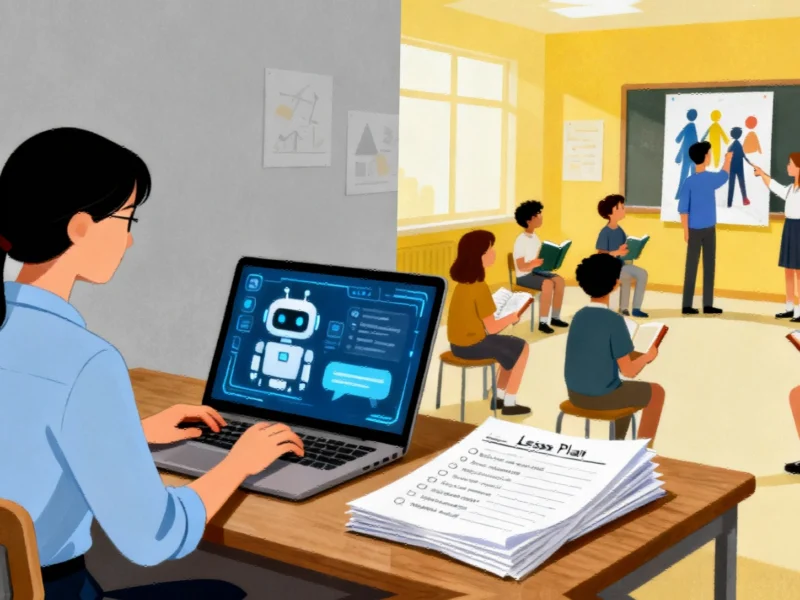The AI Teaching Assistant Paradox
As artificial intelligence tools become increasingly integrated into educational settings, a concerning trend is emerging: AI-generated lesson plans are failing to meet the complex needs of modern classrooms. Recent research reveals that despite the time-saving appeal of these technologies, the resulting educational materials often lack engagement, depth, and cultural inclusivity that effective teaching requires.
The adoption of AI in education has been rapid and widespread. A Gallup survey from September 2025 found that 60% of K-12 teachers now use AI in their work, with lesson planning being the most common application. This trend reflects broader industry developments in technology adoption across various sectors.
Research Methodology and Key Findings
In a comprehensive study conducted in August 2024, researchers analyzed 311 AI-generated civics lesson plans containing 2,230 individual activities. The investigation used three popular AI chatbots—ChatGPT’s GPT-4o, Google’s Gemini 1.5 Flash, and Microsoft’s Copilot—to generate lesson plans based on Massachusetts state standards for eighth-grade civics classes.
The analysis employed two established educational frameworks: Bloom’s taxonomy and Banks’ four levels of integration of multicultural content. The results were striking and concerning for educators hoping to leverage AI for enhanced teaching materials.
The Critical Thinking Deficit
When evaluated using Bloom’s taxonomy, which distinguishes between lower-order and higher-order thinking skills, the AI-generated lessons revealed a significant imbalance. A staggering 90% of activities promoted only basic cognitive skills—memorizing, reciting, summarizing, and applying information.
“Students were encouraged to learn civics through memorization rather than through analyzing and evaluating information, investigating civic issues, or engaging in civic action projects,” noted the researchers. This approach contrasts sharply with contemporary educational best practices that emphasize critical thinking and active learning.
The Diversity and Inclusion Gap
Perhaps more troubling was the analysis using Banks’ multicultural content framework. The AI-generated lessons presented a narrow, homogenized view of history that largely excluded the experiences of traditionally marginalized groups. Only 6% of lessons included meaningful multicultural content, and these typically focused on superficial representations like heroes and holidays rather than substantive exploration of diverse perspectives.
This finding highlights how related innovations in technology must be carefully evaluated for their real-world impact across diverse populations.
Why AI Falls Short in Educational Contexts
The fundamental limitation of current generative AI tools lies in their design and training. These systems were created as general-purpose chatbots trained on massive internet datasets, not as specialized educational tools. As the researchers explained, “From a technical perspective, chatbots such as ChatGPT, Gemini and Copilot are machines that predict the next word in a sequence based on massive amounts of ingested text.”
This technical reality means these tools cannot understand classroom dynamics, student needs, or educational context in the way human educators can. They produce generic, one-size-fits-all solutions when effective education requires flexibility, personalization, and student-centered approaches.
Practical Recommendations for Educators
Despite these limitations, the research doesn’t suggest abandoning AI tools entirely. Instead, educators should approach them as supplementary resources rather than replacement planners. The study found that while overall lesson plans were lacking, there were occasional interesting activities and stimulating ideas, particularly in homework suggestions.
Teachers can significantly improve AI-generated content by using detailed, context-rich prompts that specify:
- Desired cognitive levels from Bloom’s taxonomy
- Specific multicultural content requirements
- Classroom context and student demographics
- Preferred teaching methodologies and frameworks
This approach aligns with broader market trends toward more sophisticated use of automation technologies across industries.
The Path Forward for AI in Education
The research underscores the need for teachers to be critical users rather than quick adopters of AI-generated educational materials. As recent studies confirm, AI is not an all-in-one solution designed to address the nuanced needs of teachers and students.
Moving forward, the educational community needs more research and professional development opportunities to explore how AI might genuinely improve teaching and learning. The technology holds promise, but realizing that potential requires thoughtful integration, critical evaluation, and maintaining the essential human elements that make education effective.
As the researchers concluded, teachers should use these tools to augment their lesson-planning process rather than automate it—preserving the creativity, cultural responsiveness, and contextual understanding that only human educators can provide.
This article aggregates information from publicly available sources. All trademarks and copyrights belong to their respective owners.
